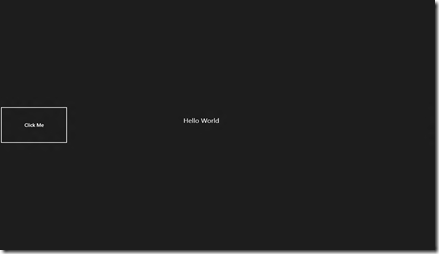We have previously explored how to write a Hello World console application using C++ /CX. Today we will develop a Hello World Application using XAML. Our Hello World app will have a simple XAML Button. Clicking the Button displays the text, Hello World on screen. ![]()
As is the case, here is our MainPage.xaml
<Page x:Class="FirstApp.MainPage" IsTabStop="false" xmlns="http://schemas.microsoft.com/winfx/2006/xaml/presentation" xmlns:x="http://schemas.microsoft.com/winfx/2006/xaml" xmlns:local="using:FirstApp" xmlns:d="http://schemas.microsoft.com/expression/blend/2008" xmlns:mc="http://schemas.openxmlformats.org/markup-compatibility/2006" mc:Ignorable="d"> <Grid Background="{StaticResource ApplicationPageBackgroundThemeBrush}"> <Button x:Name="myBtn" Width="200" Height="120" Content="Click Me" Click="myBtn_Click_1"/> <TextBlock x:Name="Hello" TextWrapping="Wrap" Width="200" Height="50" FontSize="20"/> </Grid> </Page>
Now the actual “code behind” for MainPage.xaml. Visual Studio 2011 does an excellent job of generating the initial “ref class” for MainPage. Here is the full listing for MainPage.xaml.h
// // MainPage.xaml.h // Declaration of the MainPage class. // #pragma once #include "MainPage.g.h" namespace FirstApp { /// <summary> /// An empty page that can be used on its own or navigated to within a Frame. /// </summary> public ref class MainPage sealed { public: MainPage(); protected: virtual void OnNavigatedTo(Windows::UI::Xaml::Navigation::NavigationEventArgs^ e) override; private: void myBtn_Click_1(Platform::Object^ sender, Windows::UI::Xaml::RoutedEventArgs^ e); }; }
Finally, the full implementation of MainPage ref class, MainPage.xaml.cpp
// // MainPage.xaml.cpp // Implementation of the MainPage class. // #include "pch.h" #include "MainPage.xaml.h" using namespace FirstApp; using namespace Platform; using namespace Windows::Foundation; using namespace Windows::Foundation::Collections; using namespace Windows::UI::Xaml; using namespace Windows::UI::Xaml::Controls; using namespace Windows::UI::Xaml::Controls::Primitives; using namespace Windows::UI::Xaml::Data; using namespace Windows::UI::Xaml::Input; using namespace Windows::UI::Xaml::Media; using namespace Windows::UI::Xaml::Navigation; // The Blank Page item template is documented at http://go.microsoft.com/fwlink/?LinkId=234238 MainPage::MainPage() { InitializeComponent(); } /// <summary> /// Invoked when this page is about to be displayed in a Frame. /// </summary> /// <param name="e">Event data that describes how this page was reached. The Parameter /// property is typically used to configure the page.</param> void MainPage::OnNavigatedTo(NavigationEventArgs^ e) { (void) e; // Unused parameter } void FirstApp::MainPage::myBtn_Click_1(Platform::Object^ sender, Windows::UI::Xaml::RoutedEventArgs^ e) { Hello->Text = "Hello World"; }
Finally the output on screen
Enjoy!!!

Hi Sridhar,
I am trying this code out as I am trying to understand how to navigate through pages via click button. When I get to the code on Mainpage.xaml.h I get an error of ‘virtual’ is not allowed.
what can I do to rectify this?
Hi Amy, apologies for the really slow response. were you able to resolve the issue?